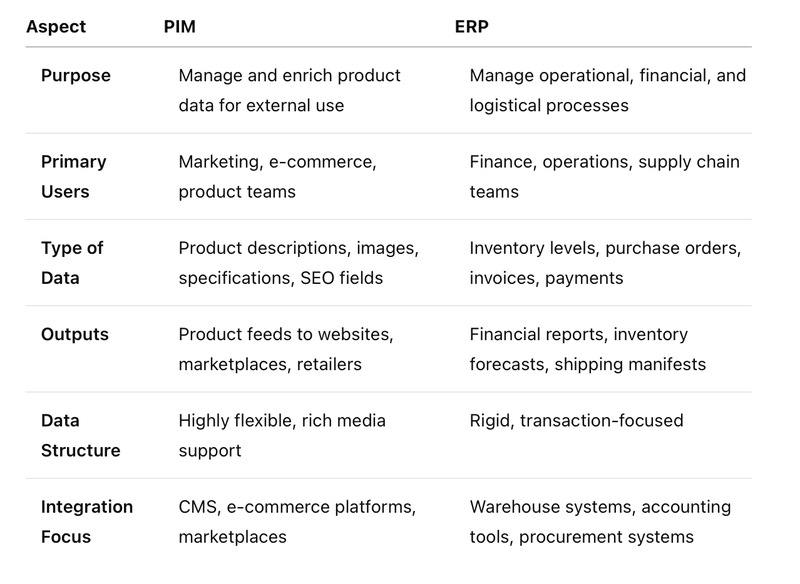This article explains the core differences between PIM and ERP, what each system is built to achieve, and where businesses can unlock the most value by using them correctly.
The Primary Goals
What a PIM is Designed to Achieve
A PIM exists to organise, enrich, and distribute product information across all customer-facing channels. It acts as the single source of truth for marketing content, technical data, images, videos, and localisation.
PIM goals:
- Deliver consistent, high-quality product content everywhere
- Reduce manual work when updating product details
- Support faster product launches
- Improve customer experience with accurate and complete listings
- Enable multi-channel and international expansion
What an ERP is Designed to Achieve
An ERP focuses on the internal operations of the business, consolidating processes such as inventory management, order fulfilment, finance, procurement, and HR. It is an operational backbone, not a marketing or merchandising tool.
ERP goals:
- Manage inventory, logistics, orders, and finance in one place
- Streamline procurement and supplier management
- Provide real-time visibility into business operations
- Ensure compliance and reporting
- Reduce administrative overhead
The Key Differences

Operational Opportunities
PIM-Driven Efficiency
- Faster channel expansion: Quickly syndicate content to new platforms without duplicate work.
- Improved content governance: Centrally control brand, tone, and localisation.
- Reduced listing errors: Structured workflows catch mistakes before they reach customers.
ERP-Driven Efficiency
- Optimised inventory management: Maintain right-sized stock levels and minimise overstock.
- Streamlined financial operations: Consolidate invoicing, payroll, and reporting.
- Improved supply chain visibility: Identify bottlenecks and delays early.
Financial Opportunities
How a PIM Contributes to Revenue Growth
- Higher conversion rates through better product content
- Faster time to market for new products and ranges
- Fewer returns and customer service issues
- Ability to enter new markets with lower operational friction
How an ERP Contributes to Cost Savings
- Lower operating costs by automating finance and procurement
- Reduced waste and stockouts through better planning
- Improved cash flow with real-time financial tracking
Common Pitfalls to Avoid
- Using ERP as a PIM: ERPs are not built to manage rich marketing content. Trying to do so leads to messy data, slow updates, and poor customer experiences.
- Keeping PIM and ERP siloed: Product and operational data must still align. Integrating PIM and ERP ensures smoother order fulfilment, product availability updates, and better reporting.
TLDR;
PIM and ERP are not competitors. They are complementary systems built for very different parts of your business. A well-structured ERP keeps operations running smoothly behind the scenes, while a strong PIM ensures that your products are presented correctly to the world.
The opportunity lies in using each system for what it is designed to do—then integrating them to create a seamless bridge between product management, customer experience, and operational excellence.
